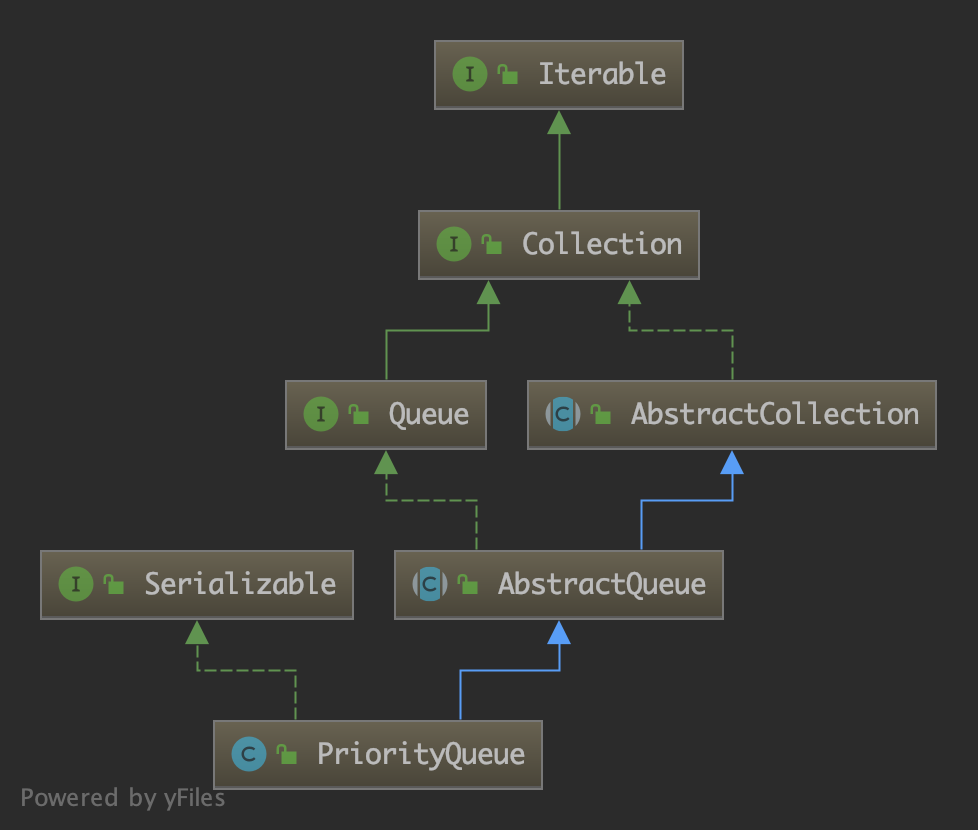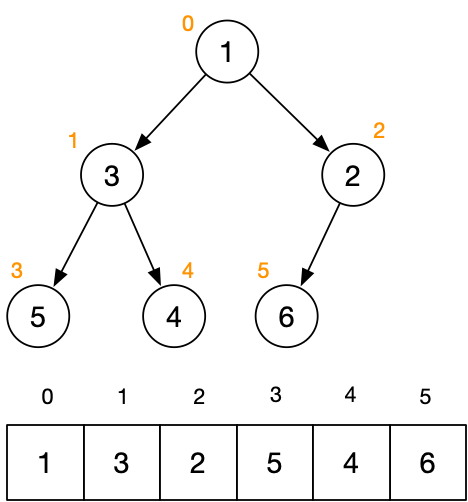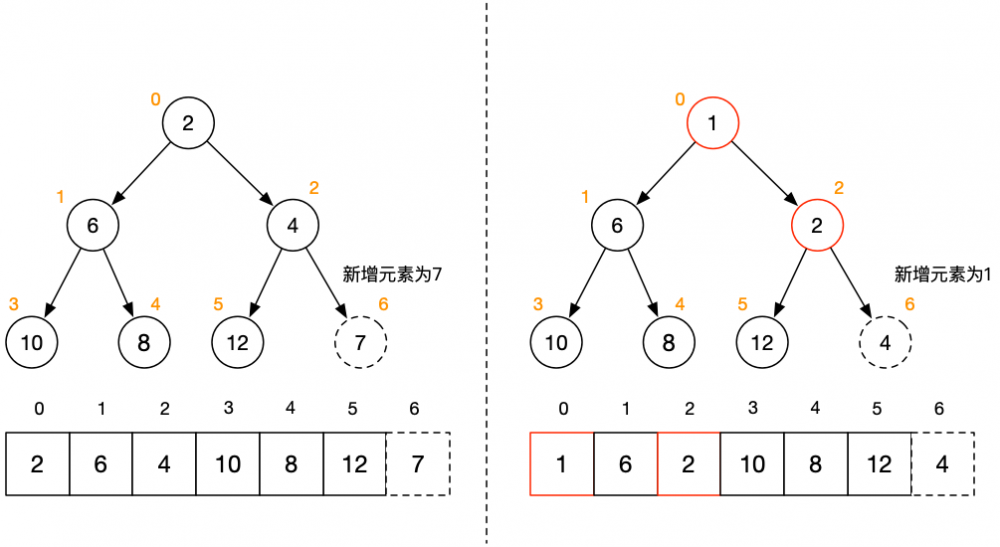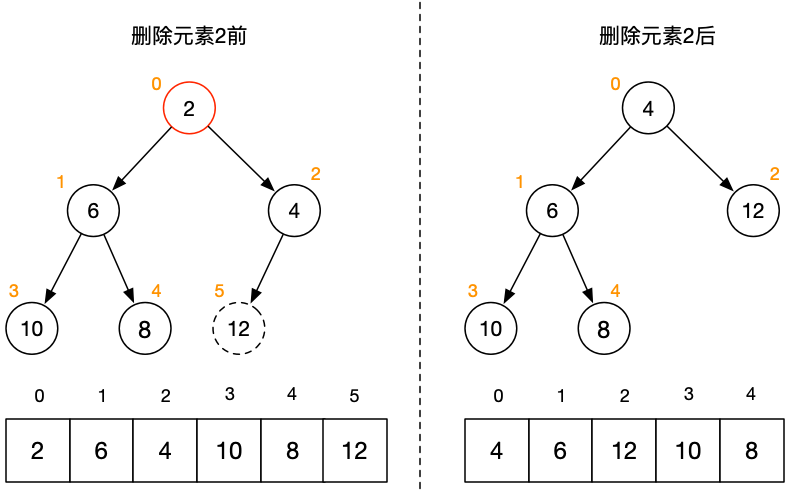JDK源码分析-PriorityQueue
概述
PriorityQueue 意为优先队列,表示队列中的元素是有优先级的,也就是说元素之间是可比较的。因此,插入队列的元素要实现 Comparable 接口或者 Comparator 接口。
PriorityQ ueue 的继承结构如下:

PriorityQueue 没有实现 BlockingQueue 接口,并非阻塞队列。 它在逻辑上使用「堆」(即完全二叉树)结构实现,物理上基于「动态数组」存储。如图所示:

有关堆的概念可参考前文「 数据结构与算法笔记(三) 」的相关描述。下面分析其代码实现。
代码分析
成员变量
// 数组的默认初始容量
private static final int DEFAULT_INITIAL_CAPACITY = 11;
// 内部数组,用于存储队列中的元素
transient Object[] queue; // non-private to simplify nested class access
// 队列中元素的个数
private int size = 0;
// 队列中元素的比较器
private final Comparator<? super E> comparator;
// 结构性修改次数
transient int modCount = 0; // non-private to simplify nested class access
构造器
// 构造器 1:无参构造器(默认初试容量为 11)
public PriorityQueue() {
this(DEFAULT_INITIAL_CAPACITY, null);
}
// 构造器 2:指定容量的构造器
public PriorityQueue(int initialCapacity) {
this(initialCapacity, null);
}
// 构造器 3:指定比较器的构造器
public PriorityQueue(Comparator<? super E> comparator) {
this(DEFAULT_INITIAL_CAPACITY, comparator);
}
// 构造器 4:指定初始容量和比较器的构造器
public PriorityQueue(int initialCapacity,
Comparator<? super E> comparator) {
// Note: This restriction of at least one is not actually needed,
// but continues for 1.5 compatibility
if (initialCapacity < 1)
throw new IllegalArgumentException();
// 初始化内部数组和比较器
this.queue = new Object[initialCapacity];
this.comparator = comparator;
}
这几个构造器的作用就是初始化内部数组和比较器。
此外,还有几个稍复杂点的构造器,代码如下:
// 构造器 5:用给定集合初始化 PriorityQueue 对象
public PriorityQueue(Collection<? extends E> c) {
// 如果集合是 SortedSet 类型
if (c instanceof SortedSet<?>) {
SortedSet<? extends E> ss = (SortedSet<? extends E>) c;
this.comparator = (Comparator<? super E>) ss.comparator();
initElementsFromCollection(ss);
}
// 如果集合是 PriorityQueue 类型
else if (c instanceof PriorityQueue<?>) {
PriorityQueue<? extends E> pq = (PriorityQueue<? extends E>) c;
this.comparator = (Comparator<? super E>) pq.comparator();
initFromPriorityQueue(pq);
}
else {
this.comparator = null;
initFromCollection(c);
}
}
initElementsFromCollection:
// 使用给定集合的元素初始化 PriorityQueue
private void initElementsFromCollection(Collection<? extends E> c) {
// 把集合转为数组
Object[] a = c.toArray();
// If c.toArray incorrectly doesn't return Object[], copy it.
if (a.getClass() != Object[].class)
a = Arrays.copyOf(a, a.length, Object[].class);
int len = a.length;
// 确保集合中每个元素不能为空
if (len == 1 || this.comparator != null)
for (int i = 0; i < len; i++)
if (a[i] == null)
throw new NullPointerException();
// 初始化 queue 数组和 size
this.queue = a;
this.size = a.length;
}
initFromPriorityQueue:
private void initFromPriorityQueue(PriorityQueue<? extends E> c) {
if (c.getClass() == PriorityQueue.class) {
// 若给定的是 PriorityQueue,则直接进行初始化
this.queue = c.toArray();
this.size = c.size();
} else {
initFromCollection(c);
}
}
initFromCollection:
private void initFromCollection(Collection<? extends E> c) {
// 将集合中的元素转为数组,并赋值给 queue(上面已分析)
initElementsFromCollection(c);
// 堆化
heapify();
}
heapify: 堆化,即将数组元素转为堆的存储结构
private void heapify() {
// 从数组的中间位置开始遍历即可
for (int i = (size >>> 1) - 1; i >= 0; i--)
siftDown(i, (E) queue[i]);
}
PS: 这里遍历时,从数组的中间位置遍历(根据堆的存储结构,如果某个节点的索引为 i,则其左右子节点的索引分别为 2 * i + 1, 2 * i + 2)。
siftDown: 向下筛选?暂未找到恰当的译法,但这不是重点,该方法的作用就是使数组满足堆结构(其思想与冒泡排序有些类似)。如下:
private void siftDown(int k, E x) {
// 根据 comparator 是否为空采用不同的方法
if (comparator != null)
siftDownUsingComparator(k, x);
else
siftDownComparable(k, x);
}
siftDownUsingComparator:
private void siftDownUsingComparator(int k, E x) {
// 数组的中间位置
int half = size >>> 1;
while (k < half) {
// 获取索引为 k 的节点的左子节点索引
int child = (k << 1) + 1;
// 获取 child 的值
Object c = queue[child];
// 获取索引为 k 的节点的右子节点索引
int right = child + 1;
// 左子节点的值大于右子节点,则二者换位置
if (right < size &&
comparator.compare((E) c, (E) queue[right]) > 0)
// 取左右子节点中较小的一个
c = queue[child = right];
// 给定的元素 x 与较小的子节点的值比较
if (comparator.compare(x, (E) c) <= 0)
break;
// 将该节点与子节点互换
queue[k] = c;
k = child;
}
queue[k] = x;
}
该方法的步骤大概:
1. 找出给定节点(父节点)的子节点中较小的一个,并于之比较大小;
2. 若父节点较大,则交换位置(父节点“下沉”)。
PS: 可参考上面的结构示意图, 其中数组表示队列中现有的元素,二叉树表示相应的堆结构, 角标表示数组中的索引(有兴趣可以在 IDE 断点调试验证)。
siftDownComparable 方法代码如下:
private void siftDownComparable(int k, E x) {
Comparable<? super E> key = (Comparable<? super E>)x;
int half = size >>> 1; // loop while a non-leaf
while (k < half) {
int child = (k << 1) + 1; // assume left child is least
Object c = queue[child];
int right = child + 1;
if (right < size &&
((Comparable<? super E>) c).compareTo((E) queue[right]) > 0)
c = queue[child = right];
if (key.compareTo((E) c) <= 0)
break;
queue[k] = c;
k = child;
}
queue[k] = key;
}
此方法与 siftDownUsingComparator 方法实现逻辑完全一样,不同的的地方仅在于该方法是针对 Comparable 接口,而后者针对 Comparator 接口,不再赘述。
此外 PriorityQueue 还有两个构造器,但都是通过上面的方法实现的,如下:
// 构造器 6:用给定的 PriorityQueue 初始化一个 PriorityQueue
public PriorityQueue(PriorityQueue<? extends E> c) {
this.comparator = (Comparator<? super E>) c.comparator();
initFromPriorityQueue(c);
}
// 构造器 7:用给定的 SortedSet 初始化 PriorityQueue
public PriorityQueue(SortedSet<? extends E> c) {
this.comparator = (Comparator<? super E>) c.comparator();
initElementsFromCollection(c);
}
也不再赘述。
入队操作 :add(E), offer(E)
两个入队操作方法如下:
// 实际是调用 offer 方法实现的
public boolean add(E e) {
return offer(e);
}
public boolean offer(E e) {
if (e == null)
throw new NullPointerException();
modCount++;
int i = size;
// 扩容
if (i >= queue.length)
grow(i + 1);
// 元素个数加一
size = i + 1;
// 原数组为空,即添加第一个元素,直接放到数组首位即可
if (i == 0)
queue[0] = e;
else
// 向上筛选?
siftUp(i, e);
return true;
}
扩容操作:
private static final int MAX_ARRAY_SIZE = Integer.MAX_VALUE - 8;
private void grow(int minCapacity) {
// 原先容量
int oldCapacity = queue.length;
// Double size if small; else grow by 50%
// 原容量较小时,扩大为原先的两倍;否则扩大为原先的 1.5 倍
int newCapacity = oldCapacity + ((oldCapacity < 64) ?
(oldCapacity + 2) :
(oldCapacity >> 1));
// overflow-conscious code
if (newCapacity - MAX_ARRAY_SIZE > 0)
newCapacity = hugeCapacity(minCapacity);
// 创建一个新的数组
queue = Arrays.copyOf(queue, newCapacity);
}
private static int hugeCapacity(int minCapacity) {
if (minCapacity < 0) // overflow
throw new OutOfMemoryError();
return (minCapacity > MAX_ARRAY_SIZE) ?
Integer.MAX_VALUE :
MAX_ARRAY_SIZE;
}
PS: 扩容操作与前文分析的 ArrayList 和 Vector 的扩容操作类似。
siftUp: 可与 siftDown 方法对比分析
private void siftUp(int k, E x) {
if (comparator != null)
siftUpUsingComparator(k, x);
else
siftUpComparable(k, x);
}
siftUpUsingComparator():
private void siftUpUsingComparator(int k, E x) {
while (k > 0) {
// 父节点的索引
int parent = (k - 1) >>> 1;
// 父节点的元素
Object e = queue[parent];
// 若该节点元素大于等于父节点,结束循环
if (comparator.compare(x, (E) e) >= 0)
break;
// 该节点元素小于父节点,
queue[k] = e;
k = parent;
}
// 入队
queue[k] = x;
}
该操作也稍微有点绕,还是以上图为基础继续操作,示意图如下:

其中分为左右两种情况:
1. 左边插入元素为 7,大于父节点 4,无需和父节点交换位置,直接插入即可;
2. 右边插入元素为 1,小于父节点 4,需要和父节点交换位置,并一直往上查找和交换,上图为调整后的数组及对应的树结构。
siftUpComparable:
private void siftUpComparable(int k, E x) {
Comparable<? super E> key = (Comparable<? super E>) x;
while (k > 0) {
int parent = (k - 1) >>> 1;
Object e = queue[parent];
if (key.compareTo((E) e) >= 0)
break;
queue[k] = e;
k = parent;
}
queue[k] = key;
}
该方法逻辑与 siftUpUsingComparator 一样,也是 Comparator 和 Comparable 接口的差别。
这里简单比较下 siftDown 和 siftUp 这两个方法:
1. siftDown 是把指定节点与其子节点中较小的一个比较,父节点较大时“下沉(down)”;
2. siftUp 是把指定节点与其父节点比较,若小于父节点,则“上浮(up)”。
出队操作 :poll()
public E poll() {
// 队列为空时,返回 null
if (size == 0)
return null;
int s = --size;
modCount++;
// 队列第一个元素
E result = (E) queue[0];
// 队列最后一个元素
E x = (E) queue[s];
// 把最后一个元素置空
queue[s] = null;
if (s != 0)
// 下沉
siftDown(0, x);
return result;
}
操作的示意图如下:

该操作的步骤大概如下:
1. 移除队列的最后一个元素,并将该元素置于首位;
2. 将新的“首位”元素与子节点中较小的一个比较,比较并交换位置(即执行“下沉(siftDown)”操作)。
删除操作 :remove(Object)
public boolean remove(Object o) {
int i = indexOf(o);
if (i == -1)
return false;
else {
removeAt(i);
return true;
}
}
indexOf(o):
// 遍历数组查找指定元素
private int indexOf(Object o) {
if (o != null) {
for (int i = 0; i < size; i++)
if (o.equals(queue[i]))
return i;
}
return -1;
}
removeAt(i):
private E removeAt(int i) {
// assert i >= 0 && i < size;
modCount++;
int s = --size;
// 移除末尾元素,直接置空
if (s == i) // removed last element
queue[i] = null;
else {
// 末尾元素
E moved = (E) queue[s];
queue[s] = null; // 删除末尾元素
// 操作与 poll 方法类似
siftDown(i, moved);
// 这里表示该节点未进行“下沉”调整,则执行“上浮“操作
if (queue[i] == moved) {
siftUp(i, moved);
if (queue[i] != moved)
return moved;
}
}
return null;
}
大概执行步骤:
1. 若移除末尾元素,直接删除;
2. 若非末尾元素,则将末尾元素删除,并用末尾元素替换待删除的元素;
3. 堆化操作:先执行“下沉(siftDown)”操作,若该元素未“下沉”,则再执行“上浮(siftUp)”操作,使得数组删除元素后仍满足堆结构。
示例代码
示例一:
private static void test1() {
// 不指定比较器(默认从小到大排序)
Queue<Integer> queue = new PriorityQueue<>();
for (int i = 0; i < 10; i++) {
queue.add(random.nextInt(100));
}
while (!queue.isEmpty()) {
System.out.print(queue.poll() + ". ");
}
}
/* 输出结果(仅供参考):
* 2, 13, 14, 36, 39, 40, 43, 55, 83, 88,
*/
示例二:指定比较器(Comparator)
private static void test2() {
// 指定比较器(从大到小排序)
Queue<Integer> queue = new PriorityQueue<>(11, (o1, o2) -> o2 - o1);
for (int i = 0; i < 10; i++) {
queue.add(random.nextInt(100));
}
while (!queue.isEmpty()) {
System.out.print(queue.poll() + ", ");
}
}
/* 输出结果(仅供参考):
* 76, 74, 71, 69, 52, 49, 41, 41, 35, 1,
*/
示例三:求 Top N
public class FixedPriorityQueue {
private PriorityQueue<Integer> queue;
private int maxSize;
public FixedPriorityQueue(int maxSize) {
this.maxSize = maxSize;
// 初始化优先队列及比较器
// 这里是从大到小(可调整)
this.queue = new PriorityQueue<>(maxSize, (o2, o1) -> o2.compareTo(o1));
}
public void add(Integer i) {
// 队列未满时,直接插入
if (queue.size() < maxSize) {
queue.add(i);
} else {
// 队列已满,将待插入元素与最小值比较
Integer peek = queue.peek();
if (i.compareTo(peek) > 0) {
// 大于最小值,将最小值移除,该元素插入
queue.poll();
queue.add(i);
}
}
}
public static void main(String[] args) {
FixedPriorityQueue fixedQueue = new FixedPriorityQueue(10);
for (int i = 1; i <= 100; i++) {
fixedQueue.add(i);
}
Iterable<Integer> iterable = () -> fixedQueue.queue.iterator();
System.out.println("队列中的元素:");
for (Integer integer : iterable) {
System.out.print(integer + ", ");
}
System.out.println();
System.out.println("最大的 10 个:");
while (!fixedQueue.queue.isEmpty()) {
System.out.print(fixedQueue.queue.poll() + ", ");
}
}
}
/* 输出结果:
* 队列中的元素:
* 91, 92, 94, 93, 96, 95, 99, 97, 98, 100,
* 最大的 10 个:
* 91, 92, 93, 94, 95, 96, 97, 98, 99, 100,
*/
小结
1. PriorityQueue 为优先队列,实现了 Queue 接口,但并非阻塞对列;
2. 内部的元素是可比较的(Comparable 或 Comparator),元素不能为空;
3. 逻辑上使用「堆」(即完全二叉树)结构实现,物理上基于「动态数组」存储;
4. PriorityQueue 可用作求解 Top N 问题。
参考链接:
https://blog.csdn.net/qq_35326718/article/details/72866180
https://my.oschina.net/leejun2005/blog/135085
Stay hungry, stay foolish.












![[HBLOG]公众号](https://www.liuhaihua.cn/img/qrcode_gzh.jpg)

